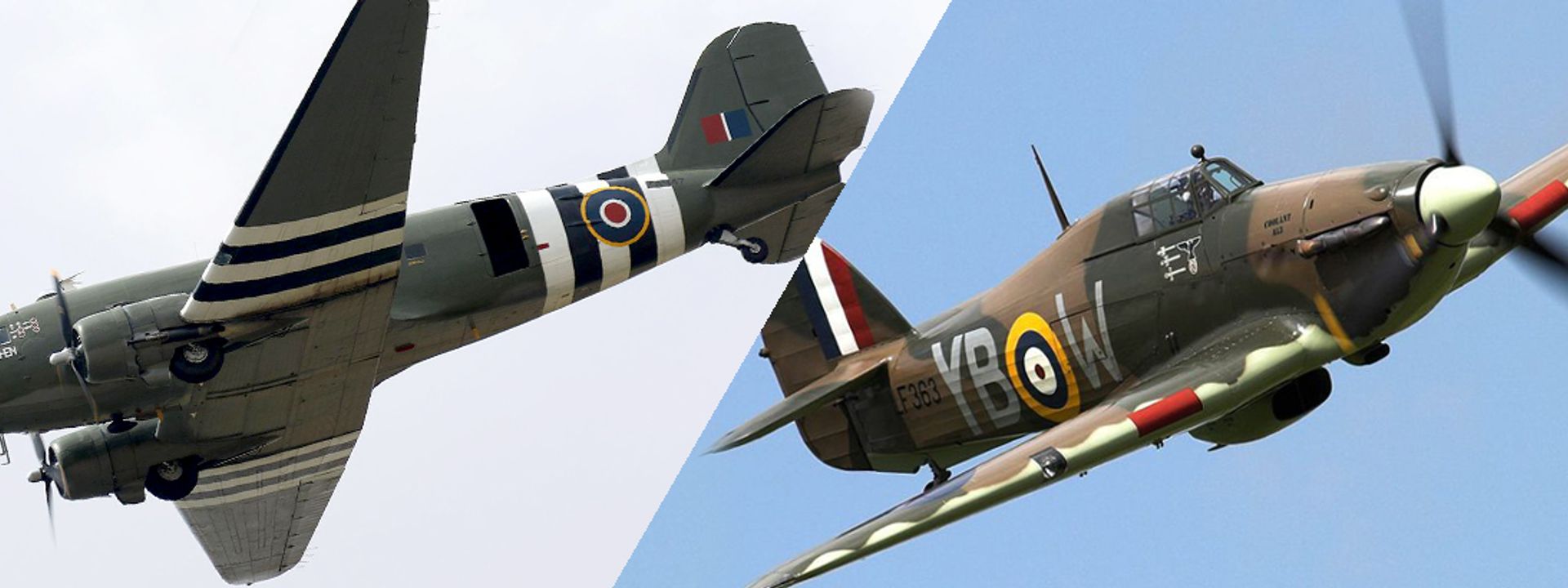
The Royal Air Force Battle of Britain Memorial Flight to Grace the Skies Over Thruxton
Two planes from the Royal Air Force Battle of Britain Memorial Flight will roar over the skies of Thruxton as part of the Thruxton Motorsport Celebration (Sat 1 - Sun 2 June). Further adding to the nostalgia on track.
The Royal Air Force Battle of Britain Memorial Flight (BBMF) operates from RAF Coningsby, a Typhoon and fighter base, in Lincolnshire.
The mission of the RAF BBMF is to maintain the priceless artefacts of the RAF's national heritage in airworthy condition in order to commemorate those who have fallen in the service of this country, to promote the modern day Air Force and to inspire the future generations.
Flown by regular serving RAF Aircrew, RAF BBMF will perform a flypast on each day of the Thruxton Motorsport Celebration with their Hurricane and C47 Dakota planes.
From May to September each year, these aircraft can be regularly seen in the skies over the UK celebrating and commemorating public and military events from State occasions such as Trooping the Colour to major air displays and flypasts for public events.
Hurricane
The Hawker Hurricane is one of the classic fighters of all time, designed and built for war. It was at the forefront of Britain’s defence in 1940 and it played a major part in achieving the victory of 1945.
Sadly, today, there are only 12 Hurricanes still airworthy worldwide; only 6 of those in UK. The BBMF is proud to operate two of these historically important and rare aircraft.
Hurricane LF363 (Mk IIc)
LF363 was built at the Hawker factory at Langley near Slough. It first flew in January 1944 and is believed to be the last Hurricane to enter service with the RAF. The aircraft served with No 63 Squadron at Turnhouse, No 309 (Polish) Squadron at Drem, where it was used on shipping protection patrols off the east coast of Scotland, and No 26 Squadron with whom it flew naval artillery spotting and reconnaissance sorties before the end of the War.
Hurricane PZ865 (Mk IIc)
The last Hurricane ever built (of 14,533), PZ865 rolled off the Hawker production line at Langley, Bucks, in July 1944 with the inscription ‘The Last of the Many’ on her port and starboard sides. Keen to preserve the last Hurricane ever built, Hawkers purchased the aircraft back from the Air Ministry and kept it in storage at Langley.
Since 2012 this famous Hurricane has faithfully replicated Hurricane Mk IIC HW840, coded ‘EG-S’, of 34 Sqn, South East Asia Command during 1944, the personal aircraft of Canadian pilot, Flight Lieutenant Jimmy Whalen DFC.
Dakota
The Douglas C-47 Dakota is without doubt one of the most successful aircraft designs in history. It became one of the world's most famous military transport aircraft and saw widespread use by the Allies during World War Two and subsequently by Air Forces and civilian operators worldwide.
Dakota ZA947
The aircraft was adopted by Strike Command and issued to the BBMF in March 1993. In 2004, an original and authentic floor and interior was re-fitted to the Dakota, returning the cabin to the original, wartime specification. As there are now no other multi-engine tail wheel aircraft in RAF service outside the BBMF, the Dakota is an important training asset used for initial training of aircrew for the BBMF multi-engine aircraft and for renewing the currency of the Flight’s Lancaster pilots each year. In addition to this role though, the Dakota is a sought-after display aircraft in her own right and, as such, she appears regularly on the air show circuit either on her own or as part of a BBMF formation. She continues to be capable of para-dropping and is used in that role for special commemorative events.
ZA947 is now painted to represent Dakota FZ692 of No 233 Squadron, around the D-Day period in 1944. This aircraft, which was named ‘Kwicherbichen’ by her crews, was involved in Para-dropping operations on the eve of D-Day and subsequently in re-supply and casualty evacuation missions into and out of forward airfields in the combat areas.